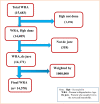Geographically weighted regression analysis of anemia and its associated factors among reproductive age women in Ethiopia using 2016 demographic and health survey
- PMID: 36136977
- PMCID: PMC9498958
- DOI: 10.1371/journal.pone.0274995
Geographically weighted regression analysis of anemia and its associated factors among reproductive age women in Ethiopia using 2016 demographic and health survey
Abstract
Introduction: Anemia in reproductive age women is defined as the hemoglobin level <11g/dl for lactating or pregnant mothers and hemoglobin level <12 g/dl for none pregnant or non-lactating women. Anemia is a global public health problem affecting both developing and developed countries. Therefore this study aims to determine geographically weighted regression analysis of anemia and its associated factors among reproductive age women in Ethiopia using the 2016 Demographic and Health Survey.
Method: In this study, a total of 14,570 women of reproductive age were included. Multi-level binary logistic regression models were employed using STATA version 14. Odds ratio with a 95% confidence interval and p-values less than 0.05 was used to identify significant factors. Spatial scan statistics were used to identify the presence of anemia clusters using Kulldorf's SaTScan version 9.6 software. ArcGIS 10.7 software was used to visualize the spatial distribution and geographically weighted regression of anemia among reproductive age women.
Result: Overall 23.8% of reproductive-age women were anemic. The SaTScan spatial analysis identified the primary clusters' spatial window in Southeastern Oromia and the entire Somali region. The GWR analysis shows that having a formal education, using pills/injectables/implant decreases the risks of anemia. However, women who have more than one child within five years have an increased risk of anemia in Ethiopia. In addition to these, in multilevel analysis women who were married and women who have >5 family members were more likely to have anemia.
Conclusion: In Ethiopia, anemia among reproductive age women was relatively high and had spatial variations across the regions. Policymakers should give attention to mothers who have a low birth interval, married women, and large family size. Women's education and family planning usage especially pills, implants, or injectable should be strengthened.
Conflict of interest statement
The authors have declared that no competing interests exist.
Figures













References
-
- Organization, W.H., Worldwide prevalence of anemia 1993–2005: WHO global database on anemia. 2008.
-
- Gebremedhin S. and Enquselassie F., Correlates of anemia among women of reproductive age in Ethiopia: evidence from Ethiopian DHS 2005. Ethiopian Journal of Health Development, 2011. 25(1): p. 22–30.
-
- Organization, W.H., Haemoglobin concentrations for the diagnosis of anemia and assessment of severity. 2011, World Health Organization.
-
- De Benoist, B., et al., Worldwide prevalence of anemia 1993–2005; WHO Global Database of anemia. 2008.
MeSH terms
Substances
LinkOut - more resources
Full Text Sources
Medical

